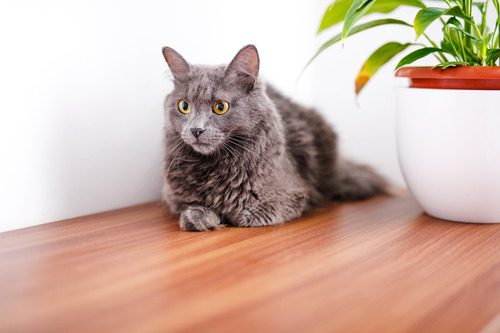Runny Nose in Cats: Symptoms and Treatment
A runny nose in cats may seem like a small problem at first glance, but it often signals an underlying issue that shouldn’t be ignored. Whether it’s a mild irritation or the early sign of an illness, nasal discharge in cats can affect their comfort, behavior, and even their ability to eat or breathe properly. Because cats are masters at hiding discomfort, pet owners might not always realize how much of a toll a runny nose is taking. If your cat’s nose is dripping more than usual, understanding what’s going on beneath the surface is the first step. In this blog, we’ll highlight the most common causes of a runny nose in cats, the symptoms you should watch for, and how your veterinarian can help. If your cat has a persistent runny nose, call Keystone Animal Hospital in Bradenton at (941) 741-8445 or request an appointment online to get your pet the care they need.

What Does a Runny Nose in Cats Look Like?
A runny nose in cats typically appears as clear or discolored discharge coming from one or both nostrils. Some cats may also have discharge crusting around their nose or sneezing fits that accompany the drip. Depending on the underlying issue, the nasal discharge can vary in appearance, from thin and watery to thick and yellow or green.
Cats with runny noses often develop other symptoms as well. You might notice them pawing at their face, breathing noisily through their nose, or showing less interest in food because they can’t smell it properly. In more serious cases, they may appear lethargic or have swollen eyes. Tracking these signs helps your veterinarian identify what’s going on more accurately.
Why Is My Cat’s Nose Runny?
There are several possible reasons a cat may develop nasal discharge. Some are short-lived and mild, while others indicate more significant health problems that require veterinary attention.
Upper Respiratory Infections
One of the most frequent causes of a runny nose in cats is an upper respiratory infection (URI). These infections are often viral such as feline herpesvirus or calicivirus, but may also involve bacteria like Bordetella bronchiseptica or Chlamydia felis. URIs can be contagious, especially in multi-cat households or shelters. Cats with a URI usually show additional symptoms like sneezing, coughing, eye discharge, fever, or a decrease in appetite. Kittens and senior cats are especially vulnerable. Even when the viral part clears, secondary bacterial infections may persist and worsen the nasal discharge.
Allergies and Irritants
Just like people, cats can develop allergies to things in their environment. Common allergens include pollen, dust, mold, cleaning products, smoke, or scented candles. These irritants can cause a mild, clear runny nose in cats, sometimes accompanied by sneezing or watery eyes. Seasonal allergies tend to cause recurring symptoms at certain times of the year. Environmental triggers can be hard to pinpoint, which is why a vet visit may be necessary to narrow down what’s affecting your cat.
Dental Disease
Surprisingly, dental issues can lead to a runny nose in cats. The roots of the upper teeth are located close to the nasal passages, so a severe tooth infection or abscess can break into the sinus cavity. This can result in one-sided nasal discharge, often thick and foul-smelling. If your cat has a runny nose paired with drooling, difficulty eating, or bad breath, a dental issue may be the underlying cause. A dental exam and possibly X-rays can help diagnose the problem.
Foreign Objects or Nasal Polyps
Sometimes, a runny nose in cats results from a foreign object stuck in the nasal passages. Grass blades, small pieces of debris, or plant matter can irritate the lining and lead to sneezing and discharge. In other cases, cats may develop benign growths called nasal polyps, especially younger cats or kittens. Foreign objects often cause sudden symptoms, while polyps may produce chronic discharge over time. A veterinary exam and possibly imaging are needed to identify and remove the issue safely.
Fungal Infections
Fungal infections such as Cryptococcus are less common but can affect the nasal cavity, especially in outdoor cats or those with compromised immune systems. These infections often cause thick nasal discharge, swelling of the nose, or facial deformity. A definitive diagnosis usually requires lab testing and imaging.
Signs It’s Time to Call Your Veterinarian
A mild runny nose that resolves in a day or two may not be a cause for concern, but persistent or worsening symptoms should prompt a visit to your veterinarian. Since cats rely heavily on their sense of smell to eat and explore, ongoing nasal issues can quickly affect their appetite and energy levels. It’s especially important to call your veterinarian if:
- The nasal discharge changes color or becomes thick
- Your cat is sneezing frequently or has watery eyes
- One side of the nose is consistently affected
- There’s swelling around the nose or face
- Your cat stops eating or seems lethargic
- There are signs of dental discomfort
Veterinarians can perform a physical exam and may recommend diagnostics such as blood work, nasal swabs, X-rays, or advanced imaging to determine the cause.
Diagnostic Process for a Runny Nose in Cats
Getting an accurate diagnosis is key to addressing the underlying problem and helping your cat feel better. The diagnostic process starts with a thorough physical exam and history.
Physical Examination and History
Your veterinarian will begin by asking about your cat’s symptoms, environment, exposure to other animals, and any recent changes in behavior or appetite. They’ll also check your cat’s eyes, nose, mouth, and throat for signs of infection, swelling, or dental disease.
Diagnostic Testing
Depending on the findings, your veterinarian may recommend:
- Nasal swabs to check for bacterial or viral infections
- Dental X-rays to assess the health of the teeth and surrounding structures
- Imaging (X-rays) to detect masses, polyps, or foreign objects
- Lab tests to identify fungal organisms or underlying immune conditions
Each case is unique, and the chosen tests will depend on the pattern and severity of symptoms.
Treatment Approaches for Runny Nose in Cats
Once the cause is identified, treatment can begin. The right approach depends entirely on the diagnosis.
Medical Therapies
For infections, veterinarians may prescribe antiviral medications, antibiotics, or anti-inflammatory drugs. Cats with fungal infections typically require antifungal medications over a longer period. Allergy management may involve removing triggers, using antihistamines, or switching to unscented household products.
Supportive Care
Supportive care plays an important role in your cat’s recovery. This may include fluid therapy for dehydration, appetite stimulants, or nutritional support. For cats with chronic infections, regular monitoring and follow-ups may be necessary.
Surgical Interventions
In cases of dental disease, polyps, or nasal obstructions, surgery may be recommended to remove the source of the problem. These procedures are often done under anesthesia and followed by home care and medication.
How Early Intervention Can Help Your Cat Breathe Easier
Prompt veterinary care can make a big difference when your cat is dealing with a runny nose. Even if the symptoms seem mild at first, they can escalate quickly, especially if an infection is involved. Cats that receive early treatment often recover faster and avoid complications like secondary infections or appetite loss. If your cat shows signs of nasal discharge or related symptoms, don’t wait to get help. Call Keystone Animal Hospital in Bradenton at (941) 741-8445 or schedule your visit online today. We’re here to help your cat breathe easier and feel better, starting with a thorough exam and the right treatment approach.
